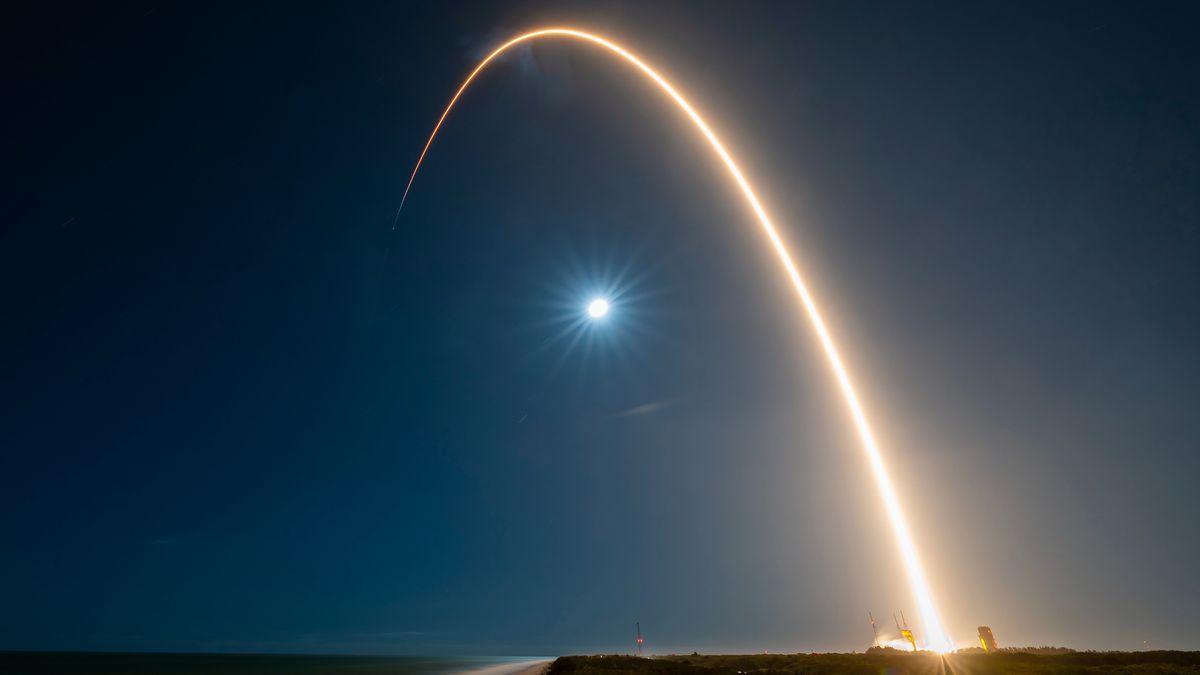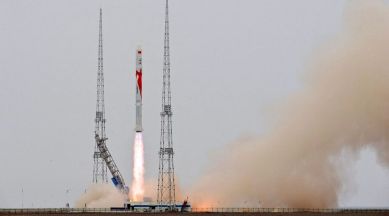SpaceX Successfully Launches 23 Starlink Satellites, Expanding Global Internet Coverage
On the evening of February 10, 2025, SpaceX marked another milestone in space exploration with the successful launch of its Falcon 9 rocket from Vandenberg Space Force Base in California. The launch took place just after 6:09 p.m. local time and was visible to many residents in Bakersfield, California, who watched the rocket’s bright ascent into low-Earth orbit.
The mission, which deployed 23 Starlink satellites, was accompanied by an impressive visual display. The rocket left a reddish streak in the sky, followed by a white glow as its first-stage booster separated from the second stage. These satellites are designed to enhance SpaceX’s ambitious plan of providing high-speed, global internet coverage through its Starlink network.
Among the 23 satellites launched, several were equipped with cutting-edge technologies to test and improve the performance of the Starlink network. These experimental satellites are designed to boost network capacity, reduce latency, and ensure more reliable broadband access, especially in underserved and remote areas. This mission represents another significant step toward SpaceX’s goal of providing fast and affordable internet to even the most isolated regions of the world.
The mission also showcased SpaceX’s ongoing advancements in reusable rocket technology. Following the successful separation of the rocket’s stages, the Falcon 9’s first-stage booster made a flawless return to the drone ship “Of Course I Still Love You” in the Pacific Ocean, marking another impressive milestone in spaceflight. This marks the 23rd successful flight for this particular booster, underscoring SpaceX’s ability to reuse rockets and reduce the costs associated with space missions.
This launch is just one piece of the puzzle in SpaceX’s long-term goal of expanding the Starlink constellation. With hundreds of satellites already in orbit, the company is steadily moving closer to providing a global satellite internet network that can connect people from every corner of the Earth.
Here is a breakdown of the 23 satellites deployed during this mission, each designed with specific functions to optimize Starlink’s capabilities:
- Starlink 1180 – Part of the core Starlink network to support global broadband services.
- Starlink 1181 – Expands network capacity for better service delivery.
- Starlink 1182 – Improves connectivity for remote and rural locations.
- Starlink 1183 – Enhances operational efficiency within the Starlink network.
- Starlink 1184 – Focuses on providing low-latency internet services for consumers in isolated areas.
- Starlink 1185 – Features experimental technology aimed at optimizing beam-forming capabilities.
- Starlink 1186 – Tests methods to minimize interference and boost bandwidth.
- Starlink 1187 – Improves communication systems to ensure more reliable data transfer.
- Starlink 1188 – Enhances satellite routing and data packet handling for smoother service.
- Starlink 1189 – Reduces network latency for applications like real-time gaming.
- Starlink 1190 – Equipped with upgraded solar panels for improved energy efficiency.
- Starlink 1191 – Introduces a new propulsion system to enhance maneuverability.
- Starlink 1192 – Expands the Starlink coverage area to new regions.
- Starlink 1193 – Implements technology for better satellite-to-satellite communication.
- Starlink 1194 – Acts as a demonstration satellite for high-bandwidth internet services.
- Starlink 1195 – Includes sensors to improve atmospheric data collection for weather forecasting.
- Starlink 1196 – Optimized for integration with other SpaceX technologies for efficiency.
- Starlink 1197 – Tests advanced AI algorithms to manage the satellite network.
- Starlink 1198 – A prototype satellite designed to test optical inter-satellite links for faster data transfer.
- Starlink 1199 – Implements new transponders to enhance coverage and data speed.
- Starlink 1200 – Provides continuous connectivity to regions without previous internet access.
- Starlink 1201 – Optimized for providing high-speed internet to densely populated urban areas.
- Starlink 1202 – Improves network redundancy to ensure reliable service.
Each of these satellites contributes to SpaceX’s vision of creating a robust and efficient global network, one that will provide broadband access to underserved regions and enhance communication worldwide.
The Evolution of Starlink: From 2019 to 2025
SpaceX’s journey toward global satellite broadband began with the first Starlink mission, Starlink 1, which took place on May 24, 2019. This landmark mission deployed 60 Starlink satellites into low-Earth orbit, marking the start of SpaceX’s ambitious plan to create a network of thousands of satellites aimed at providing low-cost, high-speed internet to underserved and remote areas worldwide.
Using Falcon 9 Block 5, the launch took place from Cape Canaveral Air Force Station in Florida, at 10:30 p.m. EDT (02:30 UTC on May 25). The mission set the foundation for what would eventually become one of the largest satellite constellations in history, designed to bridge the digital divide and offer internet access to parts of the world with limited or no connectivity.
Starlink 1 featured satellites equipped with krypton-powered ion thrusters that allowed them to adjust their position in orbit. The goal was to create a low-latency, high-bandwidth network capable of serving the most remote regions of the Earth. The mission was a resounding success, with the Falcon 9 booster landing successfully on the drone ship “Of Course I Still Love You” in the Atlantic Ocean.
Despite facing some criticism from astronomers who expressed concerns about the potential interference with telescope observations, SpaceX responded with solutions such as coating the satellites to reduce their brightness and impact on astronomical research.
Since Starlink 1, SpaceX has continued to expand the constellation with regular launches, deploying hundreds of additional satellites, and advancing the Starlink network’s capabilities. With the February 2025 mission and future launches, SpaceX is bringing the world closer to realizing a global internet network that could transform communication for billions of people.
Through relentless innovation and reusability, SpaceX’s Starlink project is shaping the future of global connectivity, offering the promise of high-speed internet access in even the most remote corners of the globe.




